Interior Decorators and Dubai's Real Estate Market
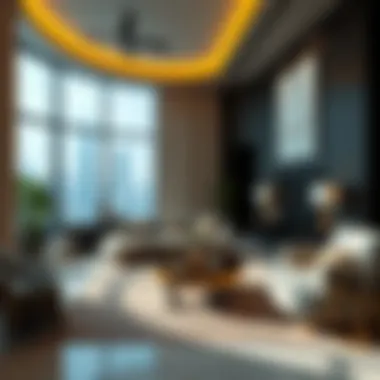

Intro
In the heart of the Arabian Peninsula, Dubai stands as a beacon of modernity and luxury, a city where the skyscrapers scrape the sky and the lifestyle is nothing short of opulent. Within this fast-paced environment, interior decorators play a pivotal role, weaving the fabric of aesthetic pleasure into the very essence of its real estate sector. This article seeks to unravel the intricate dynamics between interior design and property value, spotlighting how cultural nuances and innovative trends shape the landscape of interior decoration in Dubai.
From luxury apartments in Burj Khalifa to sumptuous villas in Palm Jumeirah, every corner of this city is characterized by unique styles and designs that reflect an amalgamation of local culture and contemporary trends. Investors, agents, and expatriates alike must understand the role that professional decorators play—not only in enhancing the visual appeal of properties but also in positively influencing their market valuation.
Key themes will emerge throughout the narrative: the intersection of modern functionality with local aesthetics, the challenges that decorators face in a competitive market, and the significance of personalizing designs to align with individual client needs. Moreover, insights will be provided into the current and future trends of interior design in Dubai, establishing a comprehensive understanding of how decorators are steering this dynamic aspect of the property market.
The Importance of Interior Decorators in Dubai
In the bustling and ever-evolving landscape of Dubai's real estate market, interior decorators play a vital role in not only enhancing the aesthetic appeal of properties but also in maximizing their market value. Their influence transcends mere decoration; it involves an acute understanding of the intricate dance between space, culture, and functionality. This section navigates through the various dimensions that underscore the significance of professional decorators within this unique environment.
Understanding the Market Dynamics
Dubai’s real estate market is unlike any other in the world. With its mix of luxury and innovation, the demand for properties is often driven by high-net-worth individuals looking for both investment opportunities and exceptional living experiences. Interior decorators serve as facilitators of this demand, crafting design solutions that cater to a diverse clientele—from expatriates seeking modern comforts to locals with a penchant for traditional grandeur.
Homeowners, agencies, and investors rely on decorators to interpret the subtleties of consumer preferences within this melting pot. Consequently, decorators engage in meticulous market analysis, keeping their fingers on the pulse of emerging trends and shifting demographics. They take into account local tastes as well as global influences, ensuring the designs resonate with potential buyers. This duality helps in understanding the market’s ebbs and flows, allowing decorators to position properties effectively.
The Role of Design in Property Value
The caliber of interior design directly impacts property valuation—this is no mere conjecture. Properties that are well-decorated often stand out in listings, naturally attracting more interest and potentially fetching higher prices. Interior decorators bring to the table a blend of creativity and strategic thinking, ensuring that each space is not only visually appealing but also functional and welcoming.
Decorators work their magic by:
- Maximizing Space Utilization: In a city where square footage often dictates value, the way space is utilized can determine a buyer's perception of worth.
- Creating Emotional Connections: A beautifully crafted interior fosters feelings of comfort and luxury, which can tip the scales in favor of a sale.
- Highlighting Unique Features: Leveraging a property’s distinctive characteristics through thoughtful design choices helps draw attention to its selling points.
In Dubai's competitive market, a property’s appeal can mean the difference between a swift sale and languishing on the market. Investing in the expertise of an interior decorator thus emerges as a savvy strategy for property owners looking to capitalize on the booming real estate sector.
"The right design can elevate a property's worth not just aesthetically but financially, making it an indispensable asset in Dubai's real estate game."
In summary, interior decorators are not just responsible for arranging furniture or choosing color palettes. They are key players who align designs with market demands, thereby enhancing property value and ensuring properties meet the aspirations of potential buyers. With the dynamic nature of Dubai’s real estate market, the importance of these professionals cannot be overstated.
Cultural Influences on Interior Design
The amalgamation of various cultural influences plays a pivotal role in shaping interior design in Dubai. This city, a melting pot of traditions and modernity, brings together elements from different parts of the world. Interior decorators, well-versed in these cultural dynamics, have the significant responsibility of blending these facets into cohesive designs that resonate with both local and foreign residents.
Understanding cultural influences is crucial for anyone involved in the real estate market here. Properties that reflect local heritage tend to attract greater interest, as buyers appreciate spaces that tell a story or embody a sense of place. For instance, traditional Middle Eastern decor elements, such as intricate mosaic patterns or rich textiles, often coexist with sleek modern finishes, creating an elegant yet practical living environment.
Blend of Tradition and Modernity
Balancing tradition and modernity can be a fine line, yet it is essential for the success of any interior project in Dubai. For example, the use of traditional Arabic calligraphy in a gallery-style layout can give a contemporary property a unique flair. Light fixtures inspired by Islamic geometric patterns can also bring an air of authenticity while still adhering to modern minimalistic tendencies.
It's not just about aesthetics; this blend can enhance the emotional resonance of a property. Buyers might feel more at home when they see elements that harken back to their roots, even if they are currently living in an ultramodern high-rise. A carefully curated space that respects local tradition while incorporating modern amenities can significantly elevate a property's marketability.
Local Aesthetics and Global Trends
As Dubai positions itself as a global city, it becomes imperative for interior decorators to remain attuned to both local aesthetics and international design trends. By doing so, they can create spaces that are not merely functional but also reflective of global sophistication.
For instance, while open-plan living is a popular global trend, this can be infused with local touches, such as courtyard-style gardens or transitional areas that showcase local plants. Furthermore, utilizing sustainable, locally sourced materials as part of the design adds value not only by appealing to eco-conscious buyers but also by honoring the area’s natural beauty.
By merging global influences with local traditions, decorators can vastly expand the appeal of a property. Potential buyers from diverse backgrounds may appreciate a home that feels familiar yet refreshingly innovative.
In summation, the cultural influences reflecting both local and global perspectives are an integral component of interior design in Dubai. The expertise of professional decorators in navigating these influences ultimately drives the success of properties within this dynamic and diverse market.
Trends Shaping Dubai's Interior Decor Landscape
Dubai's interior decor landscape is an ever-evolving realm, heavily influenced by numerous factors ranging from cultural preferences to technological advancements. These trends not only reflect the tastes of the local populace but also cater to a global audience, representing a melting pot of ideas and styles. For investors and property buyers, understanding these trends is crucial as they directly correlate with property value and market appeal.
Sustainable Design Approaches
In recent years, the emphasis on sustainable design has gained traction within Dubai's interior decorator community. As global concerns about climate change and environmental sustainability grow, decorators are increasingly incorporating eco-friendly materials and energy-efficient solutions into their designs. This approach involves the selection of locally sourced materials which not only reduces carbon footprints but also supports local artisans and businesses.
With luxury homes often setting the trends, using sustainable materials can elevate a property’s appeal. Items such as reclaimed wood, bamboo flooring, and recycled glass accents are becoming more popular, signifying that luxury and sustainability can indeed go hand-in-hand. Decorators are also adopting designs that prioritize natural light, ventilation, and overall energy efficiency, making properties not just visually appealing but also eco-conscious.
Investors looking to enhance property value through design must consider these sustainable approaches as a selling point. Properties that showcase energy-efficient systems, like smart thermostats or solar panels, not only meet modern standards but also attract environmentally aware clientele.
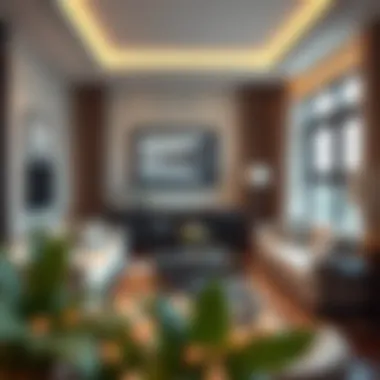
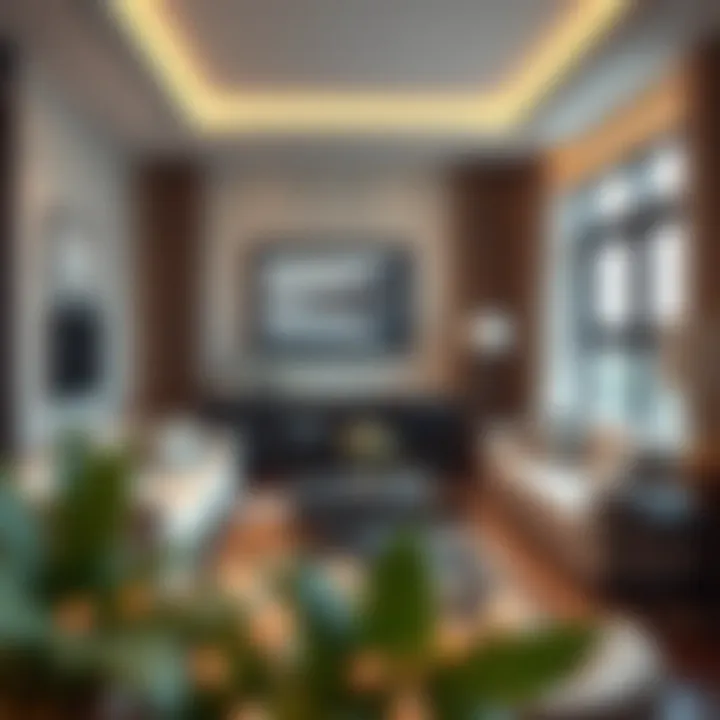
"Sustainable living isn't just a trend; it's quickly becoming the standard for luxury homebuyers."
Smart Home Integration
Another cornerstone of contemporary interior design in Dubai is the integration of smart home technology. As technology becomes ingrained in daily life, buyers expect homes that offer automation and connectivity. Interior decorators are now tasked with weaving these state-of-the-art technologies seamlessly into the decor. From automated lighting systems that adjust to natural daylight, to integrated sound systems that allow for easy entertainment, the possibilities are virtually limitless.
Smart home technology not only enhances convenience but can also significantly bolster property value. With millennials and tech-savvy investors eyeing the market, homes equipped with these features often command higher prices. Interior decorators who can skillfully blend technology with aesthetics are positioning themselves as leaders in this evolving market.
Furthermore, in a city like Dubai, where innovation is part of the lifestyle, properties featuring advanced tech become symbols of prestige. Having a home that works in tandem with cutting-edge technology can be a unique selling point that sets a property apart from others in a bustling real estate market.
In summary, the trends shaping Dubai's interior decor landscape—sustainable design approaches and smart home integration—are crucial for decorators and investors alike. They are not only about enhancing the immediate beauty of a space but are also critical factors influencing long-term property values and market demand. Understanding these trends will better equip stakeholders to navigate the vibrant and competitive Dubai real estate market.
Challenges Faced by Interior Decorators
In Dubai's fast-paced real estate landscape, interior decorators play a vital role. However, they also confront several challenges that can impact their effectiveness and creativity. Addressing these difficulties is essential not only for the decorators themselves but also for property owners and investors eager to maximize their investment. This section digs into the hurdles encountered by these professionals, shedding light on the complexities of their work.
Navigating Regulatory Frameworks
One of the most significant challenges interior decorators face in Dubai is the intricate regulatory frameworks governing building and design. The emirate prides itself on cutting-edge architecture which often comes with strict guidelines. These regulations can be viewed as a double-edged sword; while they ensure safety and quality, they can also stifle creativity and impose limitations on a decorator's vision.
It’s not uncommon for decorators to find themselves wrestling with various restrictions on materials, techniques, and even the overall aesthetic of properties. For example, any alterations to existing structures must align with Dubai's specific building codes, environmental standards, and sometimes even cultural expectations. This can lead to frustrating delays and increased costs if the necessary permits aren’t obtained in a timely manner.
Moreover, keeping abreast of changing regulations is no small feat. Architects and interior decorators alike must maintain fluent knowledge of local laws, which can shift unpredictably based on new government decrees. Falling behind on compliance can not only hinder a project's timeline but could also result in penalties or detrimental impacts on a client's investment.
Competition in a Saturated Market
The dazzling allure of Dubai's luxury real estate has led to an oversaturated market of interior decorators. With so many professionals vying for the same client base, competition has become a daunting challenge. It’s no longer enough to just have a unique design style; decorators must also carve out a niche that clearly differentiates them from others.
Many decorators are resorting to innovative marketing strategies to stand out. Social media platforms provide an excellent opportunity for showcasing portfolios, but they also introduce a risk—an overload of similar content can easily lead to market fatigue. As decorators search for ways to demonstrate their individuality, it becomes crucial to highlight not just the aesthetics of their designs, but also the process that makes their approach unique.
Moreover, as the market proliferates, price competition intensifies. This can lead to a race to the bottom, where talented decorators feel pressured to lower their fees, sacrificing quality for quantity. In such an environment, maintaining a reputation for excellence becomes both a challenge and a necessity.
"In the world of interior decor, staying ahead means constantly evolving, and that is a challenge that every decorator in Dubai must rise to meet."
Through understanding these challenges, investors and buyers can appreciate the complexities involved in creating spaces that do more than just please the eye. By addressing these concerns and facilitating thoughtful collaboration with interior decorators, stakeholders can ultimately elevate the standard of living in Dubai's vibrant real estate market.
The Client-Decorator Relationship
In Dubai's dynamic real estate market, the rapport between clients and interior decorators is a delicate dance. This relationship is not just about aesthetics; it’s a crucial aspect that can significantly affect project outcomes. A successful decor project hinges on the ability to marry client desires with the creative vision of decorators. In this context, clear communication and mutual understanding are paramount.
A strong relationship allows decorators to delve into the distinct personalities of their clients. Knowing their clients’ tastes, lifestyles, and preferences can lead to spaces that feel tailor-made. This, in turn, enhances satisfaction and facilitates a smoother collaboration throughout the design process. If decorators see clients as partners rather than just consumers, they are likely to achieve more remarkable results.
"A happy client is better than a satisfied client. It’s the difference between getting your money's worth and creating an experience that's unforgettable."
Understanding this relationship is not just about providing a service; it’s also a valuable skill that can define a decorator's success in this bustling marketplace.
Understanding Client Needs and Preferences
Grasping what clients truly want is foundational in the client-decorator relationship. This calls for a discernment of not only verbalized preferences but also unspoken desires. Listening actively during initial consultations can pave the way for decorators to get a sense of a client’s vision. Are they looking for a cozy, elegant space or something sleek and modern? Details such as color preferences, furniture style, and layout ideas can greatly influence the direction of the design.
Furthermore, decorators should consider practical aspects like the functionality and flow of spaces. Expats, who often come with diverse backgrounds and tastes, may have particular functional needs. A decorator’s role is to interpret these needs while also informing the client about what’s possible within the constraints of their budget. Recognizing the importance of cultural influences in design also fosters deeper understanding.
Personalization and Custom Solutions
Once decorators have a firm grip on their clients’ needs, the next step is to offer personalization. This is where creativity truly shines. Going beyond what’s readily available at local showrooms, decorators often pull in custom-made elements that tell a story.
Some key considerations include:
- Colors and Textiles: Choosing hues and textures that resonate with clients emotionally.
- Artwork and Accessories: Selecting pieces that reflect clients’ personalities and interests.
- Furniture Arrangements: Customizing layouts to optimize space functionality while catering to social dynamics, such as entertaining guests.
One approach that’s gaining traction in Dubai is incorporating local craftsmanship with modern aesthetics. Decorators might collaborate with local artisans to create bespoke pieces, thus enriching the project while also supporting the community. This also sets the property apart in a market that is gradually leaning towards unique and meaningful designs.
By investing time to personalize designs, decorators not only enhance client satisfaction but also create a space that feels vibrant and lived-in. This transformative journey, from mere concept to reality, strengthens the bond between decorator and client while making the design process an engaging experience.
The Impact of Professional Decorators on Property Sales
In the bustling real estate market of Dubai, professional interior decorators hold a pivotal role in shaping property sales. Their expertise goes far beyond mere aesthetics; it touches every facet of how a space is perceived and valued. Investors and real estate agents understand that the first impression can make or break a sale. For properties to stand out amid the stiff competition, decorators apply their skills in creating environments that resonate with potential buyers, thus enhancing marketability.
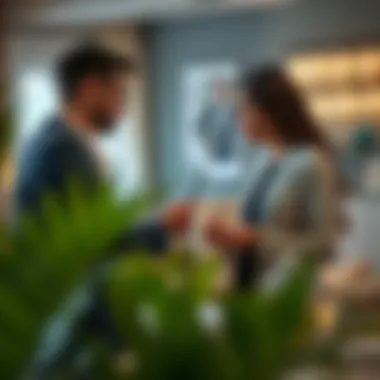

The profound influence of decorators can be boiled down to several key aspects:
- Aesthetic Value: Properties that have been thoughtfully designed tend to attract more attention. When potential buyers step into a well-decorated home, they are not just buying bricks and mortar; they are drawn into a lifestyle experience that decorators meticulously craft.
- Functionality and Flow: Interior decorators ensure that the layout of a property is not just visually appealing, but also practical. This helps sellers highlight the efficient use of space, which is particularly important in a city where every square foot counts.
- Emotional Connection: Decorators can evoke feelings. By using elements like lighting, color palettes, and furnishings, they can create warm, inviting atmospheres that foster emotional investments from buyers.
These factors collectively contribute to increasing the perceived value of a property, thereby enhancing the likelihood of a successful sale.
Enhancing Property Appeal through Design
Enhancing property appeal involves a multi-layered approach where designers harmonize elements of beauty and functionality. A skilled decorator knows how to use trends and classic styles to ensure that buyers feel instantly connected to a property.
For instance, consider a high-rise apartment in the heart of downtown Dubai. The use of contemporary furniture combined with a neutral color scheme might cater to a younger audience, while rich textures and warm hues can appeal more to families or older buyers. Key strategies include:
- Strategic Staging: This involves arranging furniture to showcase a property’s best features. For instance, placing mirrors to make a room feel larger or using art pieces to draw attention to a fireplace.
- Lighting Mastery: Lighting can transform a space. Proper use of ambient, task, and accent lighting highlights features and creates a mood that can sway buyers’ opinions.
- Diverse Themes: From minimalist to opulent Arabian styles, decorators can cater their designs to fit various market segments. This versatility can lead to a broader buyer pool.
Ultimately, well-executed design increases property appeal exponentially, often translating to higher selling prices.
Case Studies of Successful Transformations
Real-life examples bear witness to the impact of professional decorators on property sales. One notable case is a modest villa in Jumeirah that was struggling to attract interest. After a collaboration with a skilled decorator, small changes were made, such as color choices and furnishings. The once-dull living room was transformed into a vibrant gathering place that showcased its full potential.
Another example includes a luxury flat in Downtown Dubai. Initially, it flaunted generic appeal, but with the introduction of textured wallpapers and bespoke furniture, its allure skyrocketed. In both instances, the transformed properties saw increased footfall and were sold above the initial asking price.
These case studies emphasize that interior decorators can truly elevate a property to new heights, making them invaluable assets in Dubai's real estate market.
"Effective interior design is not about what's on trend, but what resonates with the buyer's heart and mind."
By harnessing the power of sophisticated decor along with a deep understanding of market preferences, professional decorators can significantly influence property sales in Dubai, unlocking the true potential of each unique space.
Sourcing Materials and Resources
Sourcing materials and resources is a fundamental aspect of interior design in Dubai's ever-evolving real estate landscape. This element involves more than just selecting colors and fabrics; it fundamentally shapes the overall experience of a space. The selection process influences both aesthetic and functional characteristics, impacting how properties are perceived on the market.
Interior decorators in Dubai must be astutely aware of the diverse materials available, each offering distinct qualities and benefits. These choices often reflect broader themes of sustainability, cultural resonance, and economic viability.
Local vs. Imported Materials
When it comes to sourcing materials, decorators face the decision of opting for local versus imported materials. Local sourcing has its advantages, such as supporting the regional economy and utilizing materials that resonate culturally with the community. For instance, materials like local stone, wood from sustainable sources, or traditional fabrics not only enhance the aesthetic value of a property but also tell a story that connects potential buyers to Dubai’s rich heritage.
On the flip side, imported materials might bring a touch of global sophistication, showcasing designs and craftsmanship from abroad. Luxury items from Italian brands or exquisite fabrics from France often elevate spaces significantly. Nevertheless, such choices may include hidden costs associated with shipping, tariffs, and longer lead times.
Factors to consider in this choice include:
- Availability: Assessing what materials can be readily sourced from local suppliers versus the lead times for imports.
- Cost Efficiency: Understanding price differences, as local products often reduce shipping fees.
- Cultural Appropriateness: Selecting materials that align with regional preferences and values.
The Importance of Quality in Design
Quality in design cannot be overstated. It acts as the backbone of any interior project, impacting not just aesthetics, but also functionality and longevity. In a competitive market like Dubai, where buyers are increasingly discerning, the emphasis on high-quality materials can make or break a sale. High-quality materials ensure that a space remains functional and appealing over time. They resist wear and tear, maintain their appearance, and reduce the need for frequent replacements.
Moreover, quality materials often contribute to aspects like energy efficiency and sustainability. For example, using high-grade insulation materials can lower energy costs and create more comfortable environments for residents. This consideration is crucial for buyers who are increasingly conscious of their ecological footprint.
In summary, regardless of the sourcing choice, the focus remains on quality as a central pillar in design decisions. Investing in superior materials pays dividends not only in the initial design impact but also in the long-term value of properties across Dubai's attractions and developments.
While the allure of imported goods is undeniable, the value of integrating local materials can foster a deeper connection between the space and its inhabitants.
The Future of Interior Design in Dubai
Interior design in Dubai is poised for a transformative journey, influenced by a cocktail of local culture and ever-evolving global trends. As the city continues to rise as a global hub for luxury living and business, fostering the right ambiance within a property becomes a critical factor for success in real estate. Interior decorators find themselves at the forefront of this evolution, carving out spaces that harmonize traditional Emirati charm with cutting-edge innovation.
Emerging Technologies in Decor
The integration of technology into interior design is not just a trend—it's rapidly becoming a necessity. Smart homes are no longer the future; they are here now. The likes of smart lighting, temperature controls, and integrated security systems are reshaping how spaces function and feel. Decorators in Dubai are increasingly reliant on technology to enhance user experience and aesthetic appeal.
Benefits of Emerging Technologies:
- Efficiency: Automating home functions can save energy and reduce utility bills, an attractive feature for potential buyers.
- Comfort: Homeowners can create environments that match their moods with the simple push of a button.
- Safety: Smart security systems offer peace of mind, critical for the high-end market.
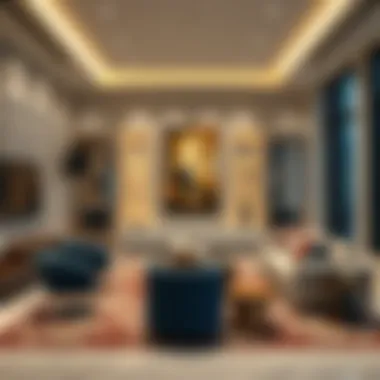
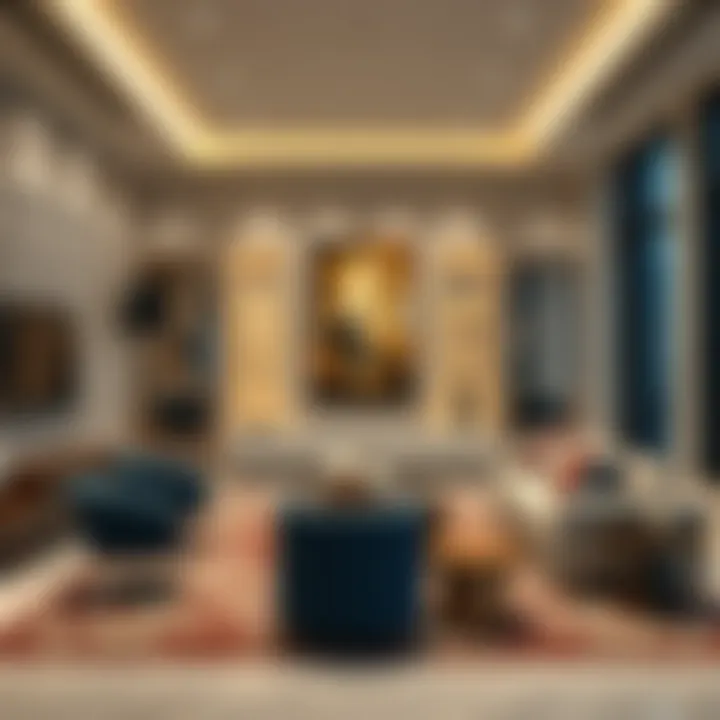
Designers are also exploring virtual reality (VR) to provide clients with a taste of their future space before any work begins. This immersive technology enables project walkthroughs, allowing clients to visualize the decor and make changes on-the-fly. More than just a gimmick, this can minimize misunderstandings and ensure satisfaction with the final result.
Emerging technologies are not only about gadgets—it's about creating liveable art that adapts to the lives of its inhabitants.
Predicting Future Design Preferences
As we look towards the horizon, predicting design preferences is key to understanding and meeting client demands. In Dubai, where luxury meets tradition, one can expect to see some fascinating shifts in tastes.
- Sustainable Materials: Eco-friendly options are anticipated to gain traction as awareness grows about environmental impact. Clients in Dubai are becoming more conscious of sustainability, thus opting for materials that are recycled or sourced responsibly.
- Cultural Reflections: A renewed interest in local craftsmanship is emerging. Decorators may lean towards integrating local artisans' work, reflecting the city’s heritage while appealing to a cosmopolitan market.
The marriage of tradition and contemporary flair will likely serve as a guiding principle. Each project will need to balance aesthetics with functionality
In Summary
The future of interior design in Dubai isn't just about aesthetics; it's about leveraging technology while respecting cultural nuances. As clients desire spaces that tell stories, decorators must possess the vision to create environments that resonate deeply. Their ability to foresee these trends and adapt will be paramount in maintaining relevance in this ever-changing landscape. Investing in the right technologies and understanding the local culture will pave the way for decorators to thrive in this unique real estate market.
Networking and Professional Development
In the vibrant and competitive landscape of Dubai's real estate market, networking and professional development hold paramount importance for interior decorators. These facets not only provide decorators with valuable connections but also equip them with the necessary skills to adapt and excel in an ever-evolving industry. Establishing a presence in local design communities and industry circles can pave the way for collaboration, referrals, and mentorship opportunities, while ongoing education ensures decorators remain at the forefront of design innovations.
Building Connections
Fostering relationships with local industry professionals, including architects, real estate agents, and contractors, can be a game changer. Collaborations often emerge from these connections, leading to joint projects that can elevate a decorator’s portfolio. When designers and builders unite, it ensures that projects are cohesive and that the aesthetic aligns harmoniously with the structural integrity of the property. Additionally, professionals who know each other are more likely to refer clients to one another.
Beyond immediate collaborations, attending industry networking events can introduce decorators to potential clients and investors, who may refrain from reaching out without personal recommendations. The essence of networking is often rooted in recommendation—clients tend to trust decorators who come highly spoken of by someone they already know.
Benefits of Strong Networks
- Access to Resources: Local connections often mean easier access to high-quality materials and unique artisanal offerings that can set a project apart.
- Market Insights: Networking helps decorators stay informed about market trends, enabling them to predict shifts and adapt their work accordingly.
- Learning Opportunities: Networking often includes learning curves; sharing insights with fellow decorators can lead to novel approaches and techniques in design.
Connect with Local Industry Professionals
To truly thrive in Dubai's interior design ecosystem, decorators must engage actively with local industry professionals. This engagement often translates to a deeper understanding of the market dynamics and the expectations of local clients. Attend exhibitions, seminars, and design fairs happening all year round in Dubai. Visiting places like Design Days Dubai, for instance, can unveil opportunities for young decorators to meet seasoned professionals and learn through exposure.
Moreover, joining organizations, such as the Interior Design Association, can provide decorators with a structured approach to networking. Active participation can lead to invitations to exclusive events or workshops, which are key to meeting influential figures in the industry.
Remember: “Your network is your net worth.”
This adage often rings true in professions reliant on recommendations and connections.
Continuing Education and Certifications
The world of interior design does not stand still; continuous learning is essential for success. Decorators who invest in their professional development through courses and certifications demonstrate a commitment to their craft. This not only enhances their skill set but also builds credibility with clients. Having certifications from recognized institutions can also become a point of differentiation in a saturated market.
Options for Education
- Online Learning Platforms: Websites like Coursera or Lynda offer courses on the latest trends and technologies in interior design that are accessible from anywhere.
- Workshops and Short Courses: Local universities or design schools in Dubai frequently run workshops that cover specific topics such as sustainable design or smart home integration.
- Certifications: Gaining certifications from esteemed organizations like the American Society of Interior Designers (ASID) can bolster a decorator’s credentials significantly.
Investing in education can improve not just the quality of work but also the professional stature of decorators, leading to more inquiries and client trust. A well-qualified decorator can command higher fees and secure more significant projects, contributing to overall market growth.
Finale and Key Takeaways
The significance of interior decorators in Dubai's real estate market cannot be overstated. They play a pivotal role in transforming a simple structure into a compelling space that resonates with both homeowners and potential buyers. Their unique ability to blend local culture with contemporary design practices not only elevates aesthetic value but directly impacts property appraisal.
In summary, the contributions of interior decorators are manifold:
- Enhancing Aesthetic Appeal: They curate spaces that are visually appealing and in tune with current trends.
- Increasing Property Value: Well-decorated homes often realize higher selling prices, providing a solid return on investment for owners.
- Personalized Experiences: Decorators ensure that every design caters to specific client preferences, making homes more inviting and marketable.
- Facilitating Sales: A properly styled property can shift from being just another listing to an attractive open house, significantly hastening the sales process.
"The right decor can transform perceptions and lead to quicker sales and better offers, proving that design is not merely aesthetic, but a strategic business tool."
Moreover, as the market continues to evolve, so does the role of decorators. With the rise of digital platforms and innovative design solutions, decorators must stay ahead of trends while maintaining a deep understanding of cultural distinctions.
By understanding the current landscape and anticipating future trends, investors and homeowners can leverage the expertise of interior decorators to maximize their real estate investments.
Summarizing the Key Contributions of Decorators
In Dubai’s complex real estate terrain, interior decorators provide significant expertise that enriches the property market. Their contributions include:
- Cultural Integration: By infusing local aesthetics into their work, decorators create spaces that feel both authentic and modern. This balancing act is crucial in a multicultural city like Dubai, where diversity thrives.
- Functional Design: Practicality meets beauty through thoughtful layouts and smart resource choices in furnishings. This ensures that spaces are not just attractive but function well for daily living.
- Market Insights: These professionals offer valuable insights into the current market landscape. They help clients understand trends in buyer preferences and potential resale values based on their designs.
Ultimately, the interplay between decorators and the real estate market enhances the overall experience for buyers and sellers alike, creating value on multiple fronts.
Future Prospects and Implications for Real Estate
As we look ahead, the role of interior decorators in Dubai's real estate sector is set to grow even more vital. New developments, changing buyer preferences, and advancements in technology all contribute to this evolution:
- Integration of Technology: The incorporation of smart home technologies and sustainable design solutions is likely to be a key focus area. Decorators will need to embrace these tools to create smarter, more efficient living spaces.
- Evolving Aesthetic Standards: With the global design trends continually influencing local markets, demand for innovative and personalized interiors is expected to surge.
- Sustainability Practices: The growing emphasis on sustainability will shape future designs, requiring decorators to source eco-friendly materials and practices, aligning their work with ethical values of buyers.











